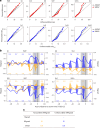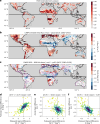Soil moisture gradients strengthen mesoscale convective systems by increasing wind shear
- PMID: 40225225
- PMCID: PMC11981932
- DOI: 10.1038/s41561-025-01666-8
Soil moisture gradients strengthen mesoscale convective systems by increasing wind shear
Abstract
Mesoscale convective systems are a class of storm linked to extensive flooding and other destructive hazards in many regions globally. In West Africa, soil moisture impacts provide a valuable source of predictability for mature storm hazards, but little is known about mature storm sensitivity to soil moisture in other climatic regions. Here we use a storm track dataset, satellite observations and reanalysis fields to investigate the response of mature storms to soil moisture in seven global storm hotspots-West Africa, India, South America, South Africa, Australia and the United States Great Plains. We demonstrate that mesoscale soil moisture gradients (~500 km) can enhance storms by driving increased vertical wind shear conditions, a crucial ingredient for storm organization, through the strengthening of atmospheric temperature gradients. This is evidenced by a 10-30% increase in precipitation feature size and rainfall for the largest storms on days with favourable soil moisture gradients compared with unfavourable gradients. Global simulations confirm that soil moisture gradients influence wind shear. The results demonstrate the importance of soil moisture feedbacks for accurate forecasting of mesoscale convective systems and future projections of extreme events under climate change.
Keywords: Atmospheric dynamics; Natural hazards.
© The Author(s) 2025.
Conflict of interest statement
Competing interestsThe authors declare no competing interests.
Figures




References
-
- Zipser, E. J., Cecil, D. J., Liu, C., Nesbitt, S. W. & Yorty, D. P. Where are the most intense thunderstorms on Earth? Bull. Amer. Meteor. Soc.87, 1057–1072 (2006).
-
- Schumacher, R. S. & Rasmussen, K. L. The formation, character and changing nature of mesoscale convective systems. Nat. Rev. Earth Environ.1, 300–314 (2020).
-
- Roca, R. & Fiolleau, T. Extreme precipitation in the tropics is closely associated with long-lived convective systems. Commun. Earth Environ.1, 18 (2020).
-
- Laing, A. G. & Fritsch, J. M. The large-scale environments of the global populations of mesoscale convective complexes. Mon. Weather Rev.128, 2756–2776 (2000).
-
- Chen, X., Leung, L. R., Feng, Z. & Yang, Q. Environmental controls on MCS lifetime rainfall over tropical oceans. Geophys. Res. Lett.50, e2023GL103267 (2023).
LinkOut - more resources
Full Text Sources
